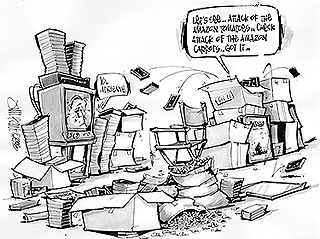 The Best of the Movies'
The Best of the Movies' The Best of the Movies'
The Best of the Movies'
First Century
What a 'Little Guy' Loves
by Edward Allan Faine
Movies, movies by the reel, who's the fairest do you feel?
It's summer's end. It's hot. You want to relax. Time to rent a video and chill out. But you've seen all the recent blockbusters and you can't quite remember where you've put that list of movies you really want to see.
Don't panic. The American Film Institute has come to your rescue. It's ranked the top 100 American films of all time for you.
The AFI top 100 films were chosen by a blue-ribbon panel of more than 1500 film "leaders," including artists in front of and behind the camera, critics, historians, movie executives and exhibitors. Choosing from a list of 400 American movies compiled by the AFI, the panel selected the 100 greatest feature-length films (see list). Judged were such factors as critical recognition, major awards, popularity over time, historical significance and cultural impact.
As a five-decade movie buff who's seen every movie on the AFI list - many more than twice - I was dismayed at many of the AFI selections. How could so many so-so movies be so highly ranked? How could so many of my favorites be left off the list?
Recoiling, I made my own list.
My favorite American films are the ones I like, pure and simple. I could care less about critical opinion, awards, popularity or historical importance. My favorites are the ones that move me, one way or the other - the ones with the greatest emotional impact that make me happy, sad, upset, grossed-out or scared witless. I don't care what Siskel and Ebert think. I don't care that Touch Of Evil (1956) first used a continuous 10-minute tracking shot or that Toy Story (1995) first used feature-length computer animation. And I certainly don't care that Annie Hall (1977) launched a female fashion trend.
It's my response to the characters, story, cinematography and musical score that matters to me. Movies are all about emotions, not who did what first or what movie had the most influence at the time.
The AFI Top 100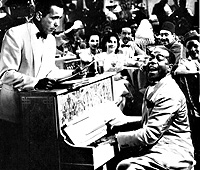
1. Citizen Kane (1941)
2. Casablanca (1942) "Play it again, Sam."
3. The Godfather (1972)
4. Gone With The Wind (1939)
5. Lawrence of Arabia (1962)
6. The Wizard of Oz (1939)
7. The Graduate (1967)
8. On The Waterfront (1954)
9. Schindler's List (1993)
10. Singin' in the Rain (1952)
11. It's a Wonderful Life (1946)
12. Sunset Boulevard (1950)
13. The Bridge on the River Kwai (1957)
14. Some Like It Hot (1959)
15. Star Wars (1977)
16. All About Eve (1950)
17. The African Queen (1951)
18. Psycho (1960)
19. Chinatown (1974)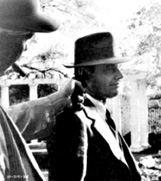 Roy Jenson, left, plays John Huston's
hired muscle. The pair add to Jack Nicholson's troubles throughout Chinatown.
Roy Jenson, left, plays John Huston's
hired muscle. The pair add to Jack Nicholson's troubles throughout Chinatown.
20. One Flew Over the Cuckoo's Nest (1975)
21. The Grapes of Wrath (1940)
22. 2001: A Space Odyssey (1968)
23. The Maltese Falcon (1941)
24. Raging Bull (1980)
25. E.T. the Extra-Terrestrial (1982)
26. Dr. Strangelove (1964)
27. Bonnie and Clyde (1967)
28. Apocalypse Now (1979)
29. Mr. Smith Goes To Washington (1939)
30. The Treasure of the Sierra Madre (1948)
31. Annie Hall (1977)
32. The Godfather, Part II (1974)
33. High Noon (1952)
34. To Kill a Mockingbird (1962)
35. It Happened One Night (1934)
36. Midnight Cowboy (1969)
37. The Best Years of Our Lives (1946)
38. Double Indemnity (1944)
39. Doctor Zhivago (1965)
40. North By Northwest (1959)
41. West Side Story (1961)
42. Rear Window (1954)
43. King Kong (1933)
44. The Birth of a Nation (1915)
45. A Streetcar Named Desire (1951)
46. A Clockwork Orange (1971)
47. Taxi Driver (1976)
48. Jaws (1975)
49. Snow White and the Seven Dwarfs (1937)
50. Butch Cassidy and the Sundance Kid (1969)
51. The Philadelphia Story (1940)
52. From Here To Eternity (1953)
53. Amadeus (1984)
54. All Quiet on the Western Front (1930)
55. The Sound of Music (1965)
56. M*A*S*H (1970)
57. The Third Man (1949)
58. Fantasia (1940)
59. Rebel Without a Cause (1955)
60. Raiders of the Lost Ark (1981)
61. Vertigo (1958)
62. Tootsie (1982)
63. Stagecoach (1939)
64. Close Encounters of the Third Kind (1977)
65. The Silence of the Lambs (1991)
66. Network (1976)
67. The Manchurian Candidate (1962)
68. An American in Paris (1951)
69. Shane (1953)
70. The French Connection (1971)
71. Forrest Gump (1994)
72. Ben-Hur (1959)
73. Wuthering Heights (1939) Geraldine Fitzgerald, Laurence Olivier, Leo G. Carroll
and Flora Robson in Wuthering Heights.
Geraldine Fitzgerald, Laurence Olivier, Leo G. Carroll
and Flora Robson in Wuthering Heights.
74. The Gold Rush (1925)
75. Dances With Wolves (1990)
76. City Lights (1931)
77. American Graffiti (1973)
78. Rocky (1976)
79. The Deer Hunter (1978)
80. The Wild Bunch (1969)
81. Modern Times (1936)
82. Giant (1956)
83. Patton (1970)
84. Fargo (1996)
85. Duck Soup (1933)
86. Mutiny on the Bounty (1935)
87. Frankenstein (1931)
88. Easy Rider (1969)
89. Platoon (1986)
90. The Jazz Singer (1927)
91. My Fair Lady (1964)
92. A Place in the Sun (1951)
93. The Apartment (1960)
94. Goodfellas (1990)
95. Pulp Fiction (1994)
96. The Searchers (1956)
97. Bringing Up Baby (1938)
98. Unforgiven (1992)
99. Guess Who's Coming To Dinner? (1967)
100. Yankee Doodle Dandy (1942)
Method to My Madness
To get at my top 100, I first scrutinized the AFI 100 list and picked my choice flicks. The most unrecognized film on the AFI list - in my opinion - is The Deer Hunter (1978: AFI #79). The Russian roulette sequences in Vietnam are perhaps the most wrenchingly brutal scenes in cinematic history, mostly because I deeply care about the three steel worker buddies (played by De Niro, Savage and Walken) after observing, in the film's first half, the rhythms and rituals of their ordinary lives in Pennsylvania before they are thrust into the horror of Vietnam.
The Deer Hunter is one of the most powerful anti-war films ever made - not so much because of its ultra-realistic depiction of war (like today's Saving Private Ryan) - but because it shows how totally and forever people are altered by war. Furthermore, the screen chemistry between Streep and De Niro is on par with the electricity between Bergman and Bogart in Casablanca (1942) and Saint and Brando in On The Waterfront (1954).
Applause for Underdogs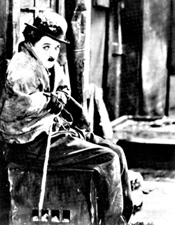
Oh, AFI, how could you give so few points to the Huston classic Treasure of the Sierra Madre (1948: AFI #30)? The sight of Bogart after that Mexican shave and a haircut! You could feel the clipped short hairs in your collar and smell the talcum powder and Wintergreen aftershave. Bogart as Fred C. Dobbs realizes the perfect screen villain in the company of superlative acting from Tim Holt and Walter Huston. Mad, paranoid greed has never been better portrayed on screen.
And isn't High Noon (1952: AFI #33) the definitive film in the "one man alone, against all" category? Gary Cooper as the abandoned town marshal awaits the noon train arrival of a just-released convict who has vowed to take revenge on Cooper for sending him to prison. The story takes place in about the same running time as the film. Tension ratchets up as the clock "tick, tick, ticks" above the plaintive wail of Tex Ritter's theme song: "Do not forsake me oh my darling/On this our wedding day " A higher rating is in order.
Three outstanding comedies, each from a different era and the equal of the highly rated Some Like It Hot (1959: AFI #14), were disfavored by the AFI leaders. Bringing Up Baby (1938: AFI #97) is the quintessential screwball comedy that perfectly balances control and mayhem; The Apartment (1960: AFI #93) showcases the young and charming Jack Lemmon and Shirley MacLaine in a satirical farce; while Tootsie (1982: AFI #62) mines sex role reversal with lots of laughs, tying Some Like It Hot for the best man-in-drag flick ever.
And how could Hitchcock's Vertigo (1958: AFI #61) not make the top 50? Has there ever been a film that better illustrates human obsession? Manipulation? And what a gorgeous whirlpooling score by Bernard Herrmann!
Certainly The Searchers (1956: AFI #96) - with an obsessed John Wayne in dogged pursuit of a kidnapped niece through Utah's Monument Valley - is John Ford's best Western. Many critics think it's the best Western ever made. I don't, but it should certainly be ranked higher.
As should the steamy Streetcar Named Desire (1951: AFI #45). Vivien Leigh gives one of the great all-time screen performances surrounded by Brando, Hunter and Malden. In my view, her flickering Blanche in Streetcar is superior to her much acclaimed performance as Scarlett O'Hara in Gone With The Wind (1939: AFI #4).
And Frankenstein (1931: AFI #87), the definitive expressionistic Gothic
horror tale that set the mold! I doubt there is a more gripping utterance
on screen than Colin Clive's mad wail "It's Alive!" Okay, purists,
maybe Orson Welles' whispered "Rosebud" receives first prize.
(The Bride of Frankenstein (1935) sequel is as good as the original by the
way.)
If you want to see Orson Welles' best movie, don't bother with Citizen Kane (1941: AFI #1). Go see The Third Man (1949: AFI #57) - a dark and moody, suspenseful story set in forever shadowy, post-war Vienna with a haunting score and many memorable moments: the Ferris Wheel scene, the cuckoo clock speech and the climactic sewer chase. Sure, Carol Reed is listed as director, but it's Welles' movie all the way (he wrote his own dialogue and influenced lighting and camera angles).
Taxi Driver (1976: AFI #47) deserves better treatment as well. What could be better than De Niro as a skinhead psychotic veteran loose in a surreal and frightening Manhattan to the accompaniment of a postmodern, percussive Bernard Herrmann score? Taken a downtown cab lately?
The AFI leaders also down-rated three outstanding suspenseful, edge-of-your-seat thrillers: The Silence Of The Lambs (1991: AFI #65), Jaws (1975: AFI #48) and Rear Window (1954: AFI #42). Remember how you felt when you watched Jodi Foster stumble around alone in that darkened basement followed by that perverted serial killer wearing night vision binoculars? Remember the sickening feeling - the abject dread, really - of watching Roy Schneider and crew being pursued by that mindless shark? And the sight of killer Aaron Burr in that lighted open doorway about to pounce on defenseless wheelchair-bound Jimmy Stewart? Whew! It was like opening the door to the vegetable creature from the '50s' thriller The Thing (1952).
Four huge blockbuster movies - Apocalypse Now (1979: AFI #28), Doctor Zhivago (1965: AFI #39), Close Encounters of the Third Kind (1977: AFI #64), and Dances With Wolves (1990: AFI #75) - also deserve higher ratings.
The great thing about Martin Sheen's psychedelic trip upriver into the heart of the Cambodian darkness was the payoff: a bloated, mumbly whale of a man spouting irrational philosophy madness. Apocalypse would have failed without the Brando topper.
Doctor Zhivago is a sweeping epic a notch below director David Lean's other great epic: Lawrence of Arabia (1962: AFI #5). The turn of the frozen winter ice palace cottage on the Russian Steppes into an endless daffodil spring (with Lara's theme in the background) is an eternal image easily recalled.
As is the final reel of Close Encounters - an exhilarating special-effects ending that elevates this movie to greatness. When the aliens come to get me - and they will - I hope they come in a Spielbergian lightship accompanied by celestial organs.
Dances With Wolves works because it brushes "one man alone, against all" across an epic background. Gorgeous cinematography. And what movie has better portrayed the plight of Native Americans in the Wild West?
The final AFI 100 underrated movie that bears mentioning is Midnight Cowboy (1969: AFI #36). great character study set in Manhattan's underbelly contrasting Jon Voight's naive Texas hustler against Dustin Hoffman's seedy Ratso Rizzo. Sadness pervades this movie, helped along by Toots Theilemans' crying harmonica on the soundtrack. Hey, AFI, a couple notches higher would be called for, don't you think?
The Last Shall be First
The next step I took to determine my list of 100 favorite flicks was to sift through the 300 films that didn't make the AFI final 100 (listed on their website -http://AFI.100movies.com). Did I find some gems? Thirty that didn't make the AFI's top 100 list!
How could the leaders overlook all-time great movies like The Hustler (1961), Twelve Angry Men (1957), The Night of the Hunter (1955), The Quiet Man (1952), Red River (1948) and The Yearling (1945)?
Three actors redefined cinematic acting in the '50s: Marlon Brando, James Dean and Paul Newman. The latter's signature performance was as the cocky, but self-destructive pool shark in the atmospheric Hustler. And who could forget Jackie Gleason's laid-back performance as Minnesota Fats, the perfect foil to Newman's high energy Fast Eddie.
Twelve Angry Men brought 12 brilliant actors together in one of the great ensemble-acting movies of all time. Again, it's "one man alone, against all" as Henry Fonda patiently turns the sequestered jurors to his point of view. This jury-room pressure-cooker of a movie is regularly shown in psychology and legal classrooms - a lasting testament to its greatness.
What can be said about The Night of the Hunter, a monochrome filmic nightmare featuring Robert Mitchum in his best role as a psychotic preacher stalking two little kids for hidden cash? Don't take your children to this one!
One of the most delightful movies of all time, The Quiet Man is -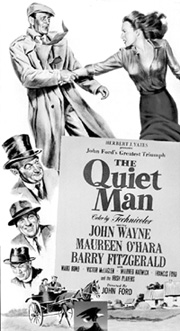
1. The charming Irish movie against which all others are to be compared;
2. John Ford's best all-around movie (that's saying something); and
3. John Wayne's best screen performance in a non-Western. This film is crammed with memorable performances: Maureen O'Hara's fiery Irish lass, Barry Fitzgerald's tipsy leprechaun, Victor Mclaughlin's gruff (but soft) squire and Ward Bond's scheming Catholic priest. Enough said!
John Wayne's best performance in a Western, however, could possibly be the classic cattle-drive movie, Red River. The scenes between the macho Wayne and the young, sensitive Montgomery Clift are charged.
On the other hand, there is no doubt that The Yearling is second only to the Wizard of Oz (1939: AFI #6) as the best American children's movie. A young boy's love for a fawn turned yearling is pitted against family hardship amid the rigors of maintaining a small family farm in the Florida outback. Gritty and realistic, this film also manages occasional surrealistic touches. Why isn't this movie regularly shown on television during holiday season like Oz and It's A Wonderful Life (1946: AFI #11)?
James Dean made only three feature films, and two are classics: the AFI-recognized Rebel Without A Cause (1955: AFI #59) and East Of Eden (1955). Both films deal with adolescent pain and the need for recognition, but Dean's humble, moody acting in the latter is superior. Anguish, that's the word that comes to mind when I visualize Dean In Eden.
For my money, I'll take Astaire/Rodgers in either Top Hat (1935) or Swing Time (1935) over the AFI highly rated Singin' In The Rain (1952: AFI #10). Gene Kelly's spectacular umbrella twirling, splash-puddle routine in Singin' does not a movie make. Each of the Fred and Ginger movies have several outstanding dance numbers with equally memorable songs: "Cheek to Cheek," "Isn't This a Lovely Day," "The Way You Look Tonight," "A Fine Romance" and "Top Hat, White Tie and Tails."
Some movies resonate, never leave your consciousness, even though the plot and acting are less than top notch, because of the cinematography and score. One such film is Days Of Heaven (1978), which perfectly captures the plight of migratory workers on the sweeping golden wheat fields of the American Midwest. Days is one of the most gorgeously beautiful films ever made, with an original score that is regularly given symphonic orchestral treatment (also recently "borrowed" for a MCI television commercial).
Speaking of musical scores, how about Duke Ellington's score for Anatomy of a Murder (1959) - a perfect match for one of the best courtroom dramas ever made. Oh, AFI, how could you pick all these wonderful movies in your top 400 films - and then shun them when it came time to select the top 100?
For sheer terror, who could deny Alien (1979) and Night of the Living Dead (1968) a place on their top 100 list? The AFI, of course.
Remember how high you jumped when the baby alien ripped out of John Hurt's belly? And the relief you felt when Ripley finally disposed of the unstoppable alien queen? Alien's impact on the collective conscience has probably been diminished by the less successful sequels, Aliens (1986), Aliens 3 (1989) and Alien Resurrection (1992). On the other hand, 2001 (1968: AFI #22) has not been tarnished by the stupid follow-up 2010 (1982).
Talking about sci-fi, The Day The Earth Stood Still (1951) is as resonant today as it was in the 1950s. I've never forgotten Christ-figure Michael Rennie and robot Gort and their warning to humankind to stop messing with nuclear power. Gort will be back!
Our pre-eminent living actors, Brando and Streep, are not in favor now, but that is no reason to overlook their monumental achievements. After a quarter of century, Last Tango In Paris (1975) is one of the sexiest mainstream movies ever made and, sadly, Brando's last stunning full performance. Sophie's Choice (1982) is one of Meryl Streep's (and Kevin Kline's) finest screen outings as well as one of the few films that captures the horrors of the Holocaust on a personal level.
In from the Cold
So much for the AFI top 400 films that didn't make the AFI 100. More egregious and shameful still was the AFI's gross neglect of many exceptional films in forming their top 400 list. How could the The Last Detail (1975) not be included? Jack Nicholson's gritty sailor is the equal of his many remarkable performances, including Chinatown (1974: AFI #19) and One Flew Over The Cuckoo's Nest (1975: AFI # 20). What criterion could have been used to keep this screen gem off the 400 list?
To say nothing of Key Largo (1948). What a cast! Bogie and Bacall, gangster-perfect Edward G. Robinson, wheelchair-captive Lionel Barrymore and Claire Trevor as a drunken chanteuse.
Of the many outstanding screen portrayals of the mentally disadvantaged - Leonardo Di Caprio in What's Eating Gilbert Grape? (1993) comes to mind, so does Billy Bob Thorton in Slingblade (1997) - Lon Chaney Jr.'s performance as the gentle giant Lenny in Of Mice and Men (1939) ranks with the best. Yet this outstanding migrant worker movie doesn't make it to the top 400. For shame.
How about another notable Depression-era movie: the Capra classic Lost Horizon (1937) with Ronald Coleman? Even without today's special effects wizardry, Horizon created a Shangri La of the mind, as easily recalled today as when the film was released over 60 years ago.
Don't miss two other neglected films depicting the American counterculture in the early '70s, each having an outstanding ensemble cast: Between the Lines (1977) and Return Of The Secaucus Seven (1980). Lines is about the staff of a radical post-'60s underground newspaper always on the brink of folding and Return features a reunion of former '60s war protesters. Both films served as models for the widely popular The Big Chill (1983).
If you want sultry and sexy with a dash of suspense and a twist ending, it's hard to beat cult favorite Body Heat (1981) - unless you're an AFI member. For funny-sad and romantic, you can't beat Jason Robards and Barbara Harris in A Thousand Clowns (1965).
And the Winners Are 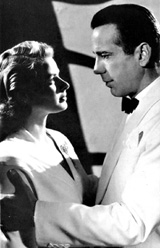
Okay, it's time for me to unveil my top 100 films of all time. (see list). Looking over my list, I particularly regret not having one movie by three great and influential directors: Woody Allen, John Casavettes or Alan Rudolph. I also regret skipping two recent favorites, The Piano (1993) with its unlikely but perfect casting of Harvey Keitel and Holly Hunter, and Dead Man Walking (1994), an emotionally laden tightwire act convincingly portraying both sides of the capital punishment issue.
Sigh! So many great movies, so little recognition.
Soooo... I've shown you my list. Now let's see yours. Bergman, Bogart and the shadows
in Casablanca, right.
1. Casablanca (1942)
2. On The Waterfront (1954)
3. The Deer Hunter (1978)
4. A Streetcar Named Desire (1951)
5. The Treasure of the Sierra Madre (1948)
6. Apocalypse Now (1979)
7. Lawrence of Arabia (1962)
8. The Godfather (1972)
9. It's a Wonderful Life (1946)
10. High Noon (1952)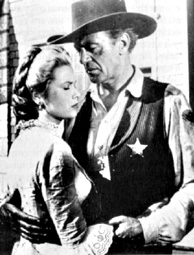 Gary Cooper, good guy even when
the odds are bad, and Grace Kelly in High Noon, left.
Gary Cooper, good guy even when
the odds are bad, and Grace Kelly in High Noon, left.
11. Taxi Driver (1976)
12. The African Queen (1951)
13. Midnight Cowboy (1969)
14. Doctor Zhivago (1965)
15. Vertigo (1958)
16. Rear Window (1954)
17. Jaws (1975)
18. The Third Man (1949)
19. Citizen Kane (1941)
20. One Flew Over the Cuckoo's Nest (1975)
21. The Bridge on the River Kwai (1957)
22. The Maltese Falcon (1941)
23. Some Like It Hot (1959)
24. All About Eve (1950)
25. Schindler's List (1993)
26. Gone With The Wind (1939)
27. The Apartment (1960)
28. Tootsie (1982)
29. Psycho (1960)
30. Raging Bull (1980)
31. North By Northwest (1959)
32. The Silence of the Lambs (1991)
33. E.T. the Extra-Terrestrial (1982)
34. Mr. Smith Goes to Washington (1939)
35. The Godfather, Part II (1974)
36. The Wizard of Oz (1939)
37. Rebel Without A Cause (1955)
38. The Hustler (1961)
39. Twelve Angry Men (1957)
40. The Night of the Hunter (1955)
41. The Quiet Man (1952)
42. Red River (1948)
43. The Yearling (1945)
44. Top Hat (1935)/Swing Time (1935)
45. Stalag 17 (1953)
46. Anatomy of a Murder (1959)
47. East of Eden (1955)
48. Mean Streets (1973)
49. Star Wars (1977)
50. Days of Heaven (1978)
51. The Last Detail (1975)
52. It Happened One Night (1934)
53. 2001: A Space Odyssey (1968)
54. Close Encounters of the Third Kind (1977)
55. The Manchurian Candidate (1962)
56. From Here To Eternity (1953)
57. West Side Story (1961)
58. Chinatown (1974)
59. Frankenstein (1931)
60. Shane (1953)
61. Bringing Up Baby (1938)
62. To Kill A Mockingbird (1962)
63. The Searchers (1956)
64. Dances With Wolves (1990)
65. Sunset Boulevard (1950)
66. King Kong (1933)
67. Marty (1955)
68. Singin' In The Rain (1952)
69. Lost Horizon (1937)
70. Alien (1979)
71. Deliverance (1972)
72. A Clockwork Orange (1971)
73. Double Indemnity (1944)
74. Snow White and the Seven Dwarfs (1937)
75. A Midnight Clear (1992)
76. Of Mice and Men (1939)
77. Key Largo (1948)
78. The Best Years Of Our Lives (1946)
79. The Day The Earth Stood Still (1951)
80. The Last Tango In Paris (1975)
81. Blue Velvet (1986)
82. Fargo (1996)
83. Platoon (1986)
84. Cabaret (1972)
85. Night of the Living Dead (1968)
86. Sounder (1972)
87. Come Back Jimmy Dean (1984)
88. Sargeant York (1941)
89. Touch Of Evil (1958)
90. The Dead (1987)
91. Between the Lines (1977)
92. Body Heat (1981)
93. A Thousand Clowns (1965)
94. The Producers (1967)
95. Return Of The Secaucus Seven (1980)
96. The Fabulous Baker Boys (1988)
97. Witness (1985)
98. Sophie's Choice (1982)
99. The English Patient (1996)
100. What's Eating Gilbert Grape? (1993)
Author's Note: The advent of well-stocked video stores and cable television makes it possible to view many of the great American movies at home. Scan the weekly TV guide and the monthly movie guides published by the cable movie channels. Many of the pre-1950 classics are broadcast regularly on American Movie Classics. Ditto for post-1960s movies on Encore, with the smaller movies on Bravo. For example, both The Third Man and A Midnight Clear were shown in August.
Edward Allen Faine is publisher of the mid-Atlantic literary magazine Fodderwing, which features an article on the arts every issue. The current issue features the neglected late 1940s' films of Bette Davis. Faine is also publisher of Little Magothy and Other Stories by Annapolis author Bruce L. Wilson and Spirit-Walking by Deale author Carolyn Stearns. To talk movies, magazines or books reach Faine at 310/587-1202
Readers' Picks
Please, not a whole hundred. We'll settle for 10. Send us your top 10 list of the 20th century's best American movies, plus your name and a brief statement of your self-defined credentials. We'll share them with our readers and keep the popcorn popping. (Add phone number for verification and address so we can mail you a copy.) Mail or fax to NBT Movie Madness, Post Office Box 358, Deale, MD 20751 410/867-0307.
| Back to Archives |
VolumeVI Number 36
September 10-16, 1998
New Bay Times
| Homepage |